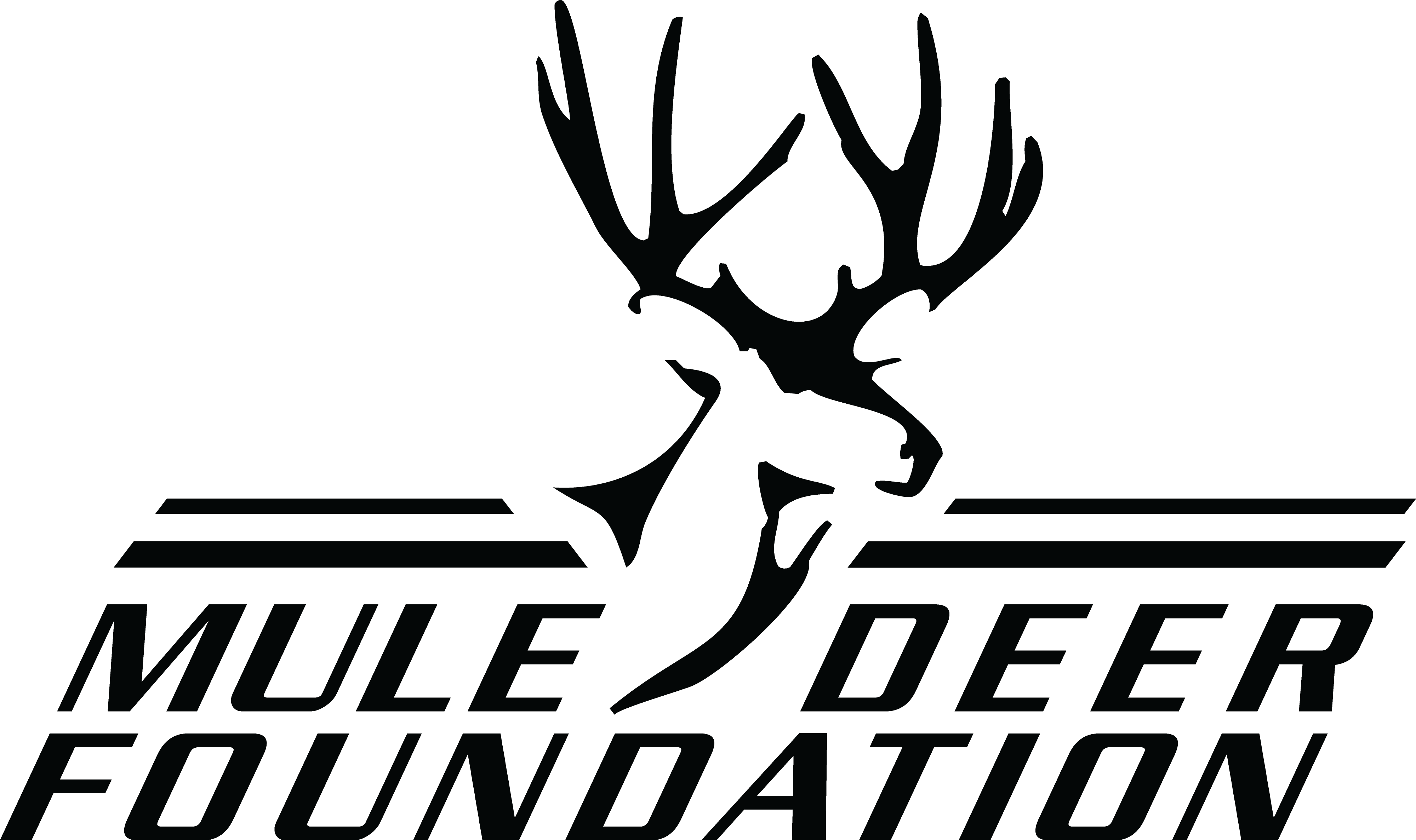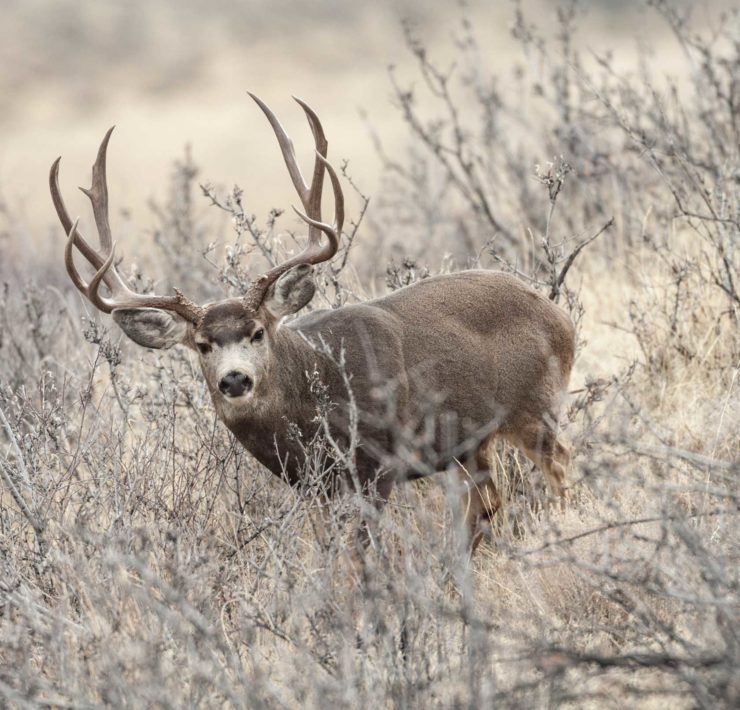Alaska State Spotlight
The Mule Deer Foundation is the only conservation group in…
WASHINGTON, IDAHO AND ALASKA REGIONAL SPOTLIGHT
For a late summer evening in north central Washington, the weather was very mild as we watched a small waft of smoke rising over a distant ridge to the west. We were in the middle of a wrap-up and strategy meeting for MDF in our region, talking about the needs of our mule deer, fundraising ideas and future project possibilities, when suddenly our future was decided for us in what seemed like an apocalyptic event.
Fire was definitely a trending word this year in both Washington and Idaho, and the stage is set for MDF to step up to the plate in our region and make a difference like we’ve never been asked to do before. That small column of smoke we had been watching erupted into a towering cloud rising 60,000 feet high and covering most of the western horizon. What we had witnessed was the explosion of a small blaze into what would become a more than quarter-million acre wildfire in the heart of Washington’s best mule deer region. Driving home that night, ash was still falling on the truck more than 100 miles away, and we immediately knew that a huge challenge had been set before us.
Focusing on Restoring Habitat after Wildfires
Habitat restoration due to fires is nothing new for the Mule Deer Foundation, so we know we have the proper resources and network to get the work done. Over the last several years, close to 1 million acres of habitat have been lost to fires in Washington and Idaho, many of those in prime mule deer country. To that end, MDF has put a major focus on raising funds and awareness to help restore much of this critical resource. Many multi-agency meetings have been held in both states to find best practices for attaining our goals and local chapters are ramping up efforts to ensure the success we need.
Okanogan, Chelan and Kittitas Counties in central and north central Washington have been our hardest hit. MDF chapters in Omak, Twisp, Ellensburg and Yakima have worked hard to dedicate volunteer hours and Chapter Reward dollars towards projects to replace bitterbrush, sagebrush and bunch grass, along with multiple other plant species. The Central Washington Chapter logged nearly 700 volunteer hours in 2014 protecting and replacing lost or damaged habitat. An aspen fencing project and two bitterbrush projects were among the events they planned and completed, getting more than 200 acres back on track. As one of Washington’s newest and most active chapters, they are setting a great example of what’s possible for a dedicated group – they were even the stars of the local parade through town last year, adorning hundreds of local youth with our M.U.L.E.Y. antlers!
The Okanogan Trails and Okanogan Valley Chapters, both in hard-hit Okanogan County, have been holding fundraisers and awareness for future habitat work that will continue for years. With over 250,000 acres of prime mule deer habitat lost to wildfires, the challenges are huge. Working closely with Washington Department of Fish and Wildlife (WDFW) this year, we have been putting together a plan of action and are preparing to begin our planting and restoration work. Luckily, we have had a very mild winter so far this year, and many of the migrating deer have been able to disperse, relieving some of the expected pressure on what little winter range remained. Our main focus is to re-establish and protect as much winter range as we can for the next couple of years. If pressure remains light, the recovery of our mule deer will proceed as hoped. In a few years, this area will be an incredible resource for mule deer, we just need to work hard restoring habitat to avoid too much hardship on the populations in the near future. A recent “Call for Projects” has just been issued by the local chapters and, together with state and federal agencies, we will prioritize and fund as many of these project requests as we can. The chapter members and other volunteers will also be helping with many work parties to restore habitat and infrastructure as needed.
In Idaho, one of the hardest hit areas from wildfires has been the southwest corner of the state. MDF currently does not have a chapter in the Boise area, Idaho’s largest population center, but we are working in that part of the state to restore lost habitat nonetheless. Unit 45, considered one of Idaho’s best trophy units for mule deer, was especially hard hit with fires and one donor in particular has stepped up to help. For two years in a row, Spring Cove Outfitters has donated a trophy archery mule deer hunt, with all proceeds going towards restoration work in Unit 45. Last year, this donation raised $7,500 at the local Magic Valley Chapter banquet in Twin Falls. Hopes are high this year for a similar result, which will enable the chapter and state to provide much needed work in that unit. Another huge donor in the area is Conservation Seeding and Restoration, a company formed by a local conservationist, Steven Paulsen. CSR’s mission is to help restore and re-establish habitat, and mule deer fall high on their list of priorities. To aid our chapters with their goals, CSR has offered seed, seed mixtures and plugs at greatly reduced prices, allowing the chapter’s hard earned dollars to stretch even further. Generous donations such as these are helping us achieve more, quicker than we had planned, which is a great thing for our mule deer!
Chapter Funding Supports Conservation
Another hot topic, and probably one of the most controversial in the West today, is the issue of wolves and the effect they are having on mule deer. Whatever perspective you may hold, it is clear that wolves are having an impact on our local wildlife populations and their habits. MDF chapters in Washington and Idaho are actively funding research projects and management costs to help us learn more and help manage all of our wildlife. In the Idaho Panhandle, $4,000 of local chapter rewards and national funds were issued to help offset direct costs of managing wolf populations, both through lethal and non-lethal means. MDF will continue to help with these opportunities and hopefully we will begin to see a turn in the current trend there. In Washington, the Spokane, Yakima and Okanogan Trails Chapters have helped fund a research study throughout northern Washington on the effect wolves may be having on coyote predation of mule deer fawns. This new study could help show us other effects the introduction and spread of wolves is having on not only mule deer but also all species in the affected regions. MDF is a strong believer in proper management of wolves and all wildlife, and we will continue to support these goals.
Other chapter projects in 2014 in Washington are numerous and varied. The Skagit Valley Chapter funded multiple infrared trail cameras and a new black-tailed deer decoy to WDFW officers to help curtail local poaching. The South Sound Chapter in Olympia spent over $5,000 to fund a research project to determine the possible effects of herbicide use on new timber cuts and how it may lower black-tailed deer fawn survival. Other funding has been used to buy new metal detectors for WDFW to aid in poaching cases, and more robotic decoys coming soon for enforcement officers. Many new projects coming up include invasive weed control (Mediterranean Sage), invasive grasses and knapweed outbreaks, as well as habitat plantings across central and eastern Washington. Closely working with agencies and local land trusts, MDF is also looking into more work with conservation easements and assisting the state with keeping lands wild and out of development.
In Idaho, the Magic Valley Chapter purchased equipment for Idaho Department of Fish and Game (IDFG) law enforcement to aid them with poaching issues. The Henry’s Fork, Snake River, and Southeast Idaho Chapters have all directed chapter rewards towards habitat on a number of different wildlife management areas including aspen restoration and wildfire restoration projects in the south and more wolf research in the northern part of the state. One of the new focuses in Idaho and Washington will also be the development of multiple M.U.L.E.Y. events, introducing more youth to the outdoors and shooting sports as well as the importance of good stewardship and conservation. Our new M.U.L.E.Y. coordinator, Amanda Lowrey, is looking forward to helping both states build these events and see our youth learn more about the great outdoors.
As a result of very dedicated chapter members and a determined national office, in the last three years MDF has put over $115,000 on the ground in Washington, and nearly $100,000 on the ground in Idaho. Also, Alaska has put almost $15,000 into black-tail research and habitat projects. With many more large and small projects on the horizon, growth and fundraising are top priorities for us in this region over the next few years.
Building our Pacific Northwest Chapters
The Pacific Northwest region chapters have seen incredible growth recently and we are on track for even more. Washington currently has 10 active chapters planning fundraisers and projects, and the volunteer ranks are growing! Many chapters are seeing a rebirth of sorts, reaching out to new committee members and introducing new ideas for their chapters. With a goal of 15-18 chapters statewide, Washington is over halfway to what we hope to achieve in chapter numbers. Reaching this goal will allow us to do much more than we currently are, and have a wider reach in educating the public about important issues to wildlife. Membership numbers have surpassed 3,600 in this state, giving MDF a great representative voice. We hope to do much more in the coming years, growing our chapter system, membership, and overall effect on wildlife statewide.
Idaho now has 5 active chapters, and our goal is to build upwards of 10 chapters statewide. Because of Idaho’s unique geography and population spread, there is much of the state devoid of any towns or communities. This provides thousands of square miles of wilderness for the public to enjoy, but limits us in the possible number of chapters to help maintain all of this land. Because of that, local chapters in Idaho take a larger burden upon themselves determined to help statewide with our mule deer and management issues even when hundreds of miles from the nearest chapter. This kind of dedication nationwide is what makes MDF such a remarkable and effective organization – there is no doubt we have the best volunteers around! Idaho’s membership is now over 1,900, and with this year’s outreach just beginning, we should break the 2,000 mark by spring. This is providing us with a stronger voice in the state, and a workforce determined to make a difference. Idaho’s newest chapter, the Idaho Panhandle Chapter, in Coeur d’Alene, is planning on making youth outreach a priority, and focusing on introducing our youth to the great outdoors. This goal will guarantee that we do not lose the heritage of our outdoors in the future, and will provide stewards of our wild lands for generations.
Alaska has been seeing steady growth in the last 2 years, and we are now up to 4 chapters in the state. The newest chapter, on Prince of Wales Island, is putting on their first banquet this year. With two projects already funded on the island, they have a solid start to making a difference in the Sitka black-tail populations. The Northern Lights Chapter in Fairbanks, Alaska is our northern-most chapter and is looking forward to helping youth enjoy the outdoors and shooting sports even more. Two other chapters in southeast Alaska, in Sitka and Ketchikan, have devoted members that are looking at what opportunities arise. Southeast Alaska is one of the very unique places where deer are a subsistence animal, and the Sitka black-tail plays a vital role in the livelihoods of the people there. This gives them a different perspective than most, as they depend on this animal to survive. This fact, along with other distinctive issues there, provides MDF some new challenges that we look forward to pursuing. With some of the last old growth rainforest, southeast Alaska provides some of the most breathtaking and dense forests around. Managing the old growth as well as the second growth forests can and will provide much-needed new forage for deer, helping their populations flourish. These deer also have co-existed with large populations of black bear and wolves for generations. Learning more about these population dynamics may well help us manage our wildlife better in the lower 48, and we look forward to continued work in the “Last Frontier”.
Looking Ahead
The states of Idaho and Washington are undergoing other growth and improvements as well. We are actively working on forming Project Review Committees (PRCs) for both states, to help us do more with our Chapter Rewards. This process will enable chapters to pool their dollars, giving us opportunity to do larger projects on a landscape scale affecting thousands more acres than we currently can. These PRCs will include chapter representatives and key agency personnel from state, federal and private agencies. Input from private landowners will also be used in deciding what projects will give us the most effective use of chapter, state and federal dollars to be put on the ground for mule deer. Another idea that is gaining support is to begin a yearly rendezvous for chapters. This will provide a weekend of fun, camaraderie and learning for volunteers, and hopefully the opportunity to make some lasting friendships across the states. Learning that “you aren’t alone” as a chapter can have great impacts on ideas and the motivation to do more. We can always do more as a team and this weekend get-together will provide a platform for new growth for all chapters, in many ways.
Without our volunteers, MDF would not be able to accomplish the great things we do in our region and nationwide. Volunteers are the lifeblood of our organization and we sincerely appreciate all that you do every year. From new committee member, to chapter chair, volunteer M.U.L.E.Y. coordinator and state chair, all volunteers play an integral role in our success. As the years go by, it is important to continuously recruit new help and new ideas. Some of our veteran volunteers love what they do, but eventually would like to see new blood take over.
After 13 years of involvement with MDF and 10 years serving as a state chair, Mike Jones of the Spokane Chapter has decided to step back and turn over the reins to a new state chair in Washington. Mike has worked tirelessly for the past decade to help find new chapter leads, contact businesses and individuals to rally support for MDF, and promote our organization. He has helped us reach new levels in Washington, and his dedication and hard work have been invaluable. Mike has been a great friend to MDF and all of us personally, and we look forward to keeping him around for a long time to come. Thank you, Mike for all you have done for MDF!
Mike’s successor is fairly new to MDF, but more than qualified in knowledge, enthusiasm and a love for the Mule Deer Foundation. Rachel Shilley-Voss stepped up to take over the Yakima Chapter two years ago when their banquet chair stepped down, and she built a new committee that has grown that chapter and turned it into a new direction, reaching many new members. She also has jumped right in to attending and maintaining promotional booths at local sports shows and multiple Cabela’s days as well as going on local radio programs to promote MDF. She is excited to help move MDF to new levels in the future, and we are lucky to have her supporting us! Rachel just received the “Elite Volunteer Award” at our convention in February, an award only given out once before in MDF’s history. This award is given to a volunteer who has gone above and beyond, particularly during times of personal struggle. Through her trials, Rachel has never stopped working for MDF and has been an incredible example and voice for us. We look forward to seeing what she comes up with next!
Whether it is fire rehabilitation, collaring deer for research, controlling invasive weeds, teaching our youth the importance of our outdoors and stewardship, helping our law enforcement, or any other of a multitude of projects, we at MDF in the Pacific Northwest Region and nationally look forward to continuing our hard work for the mule deer and black-tailed deer that we love. Thank you all for being a part of our story, and we look forward to more successes in the future!
The Mule Deer Foundation is the only conservation group in North America dedicated to restoring, improving and protecting mule deer and black-tailed deer and their habitat, with a focus on science and program efficiency. MDF is a strong voice for hunters in access, wildlife management and conservation policy issues. MDF acknowledges regulated hunting as a viable management component and is committed to recruitment and retention of youth into the shooting sports and conservation. Get involved in your state or become a member at www.muledeer.org or call 1-888-375-3337.



